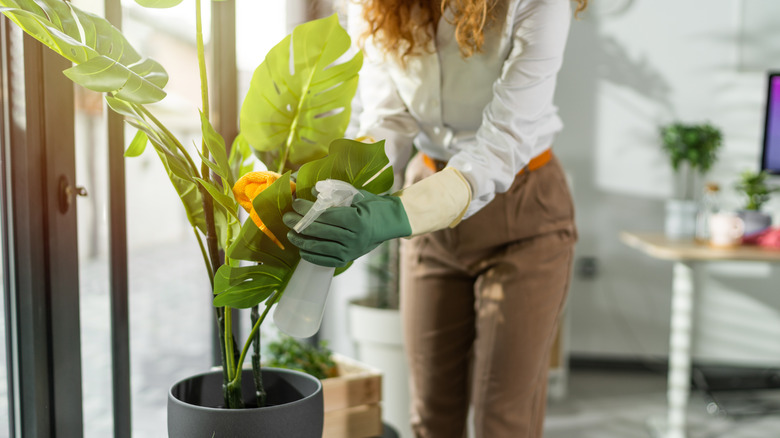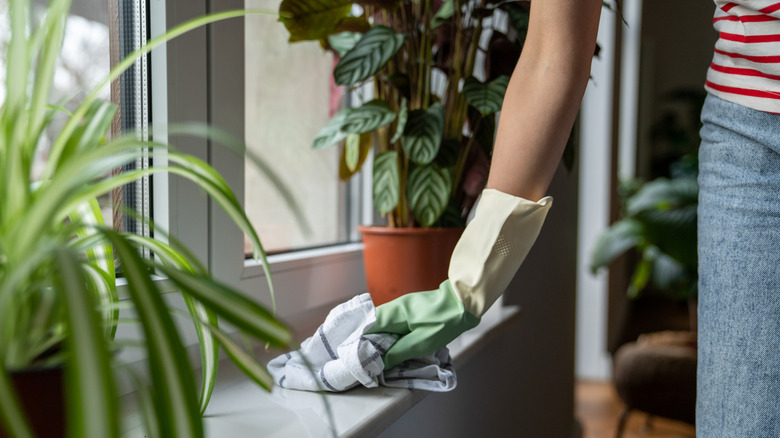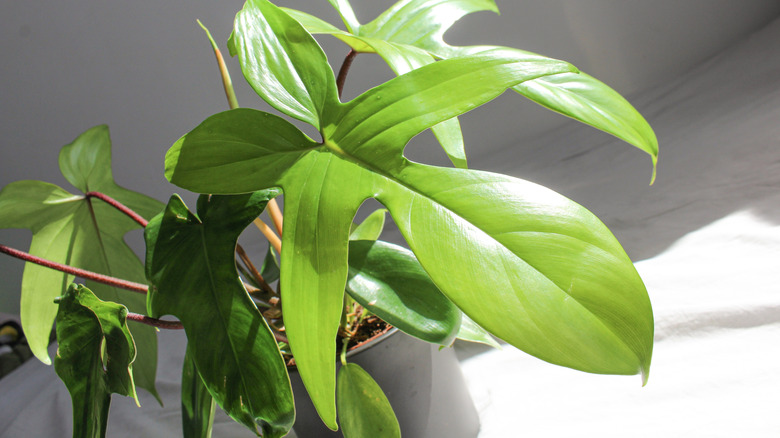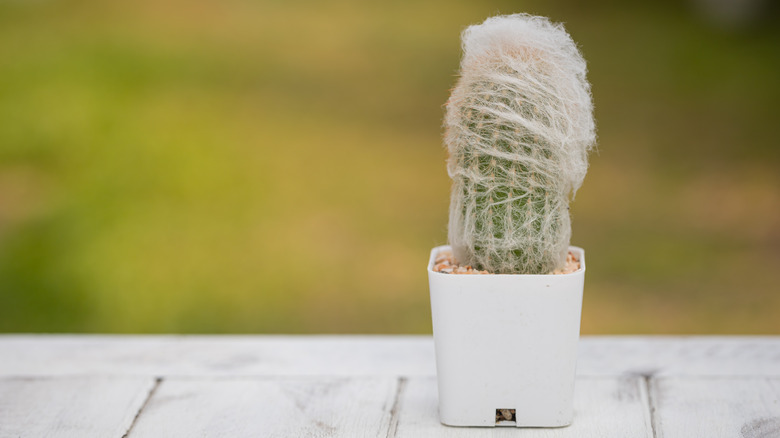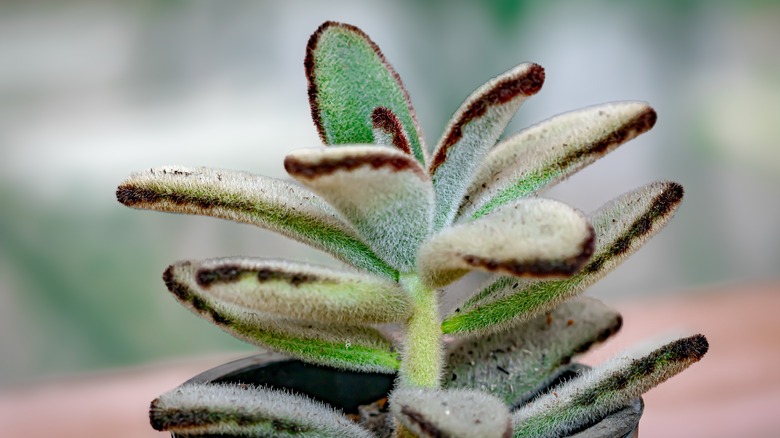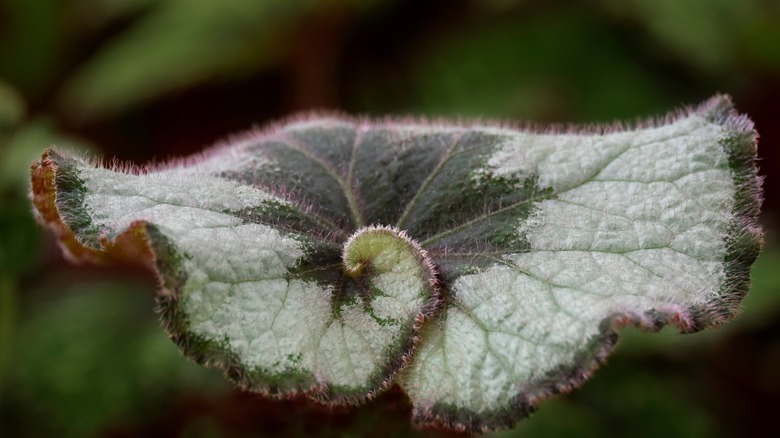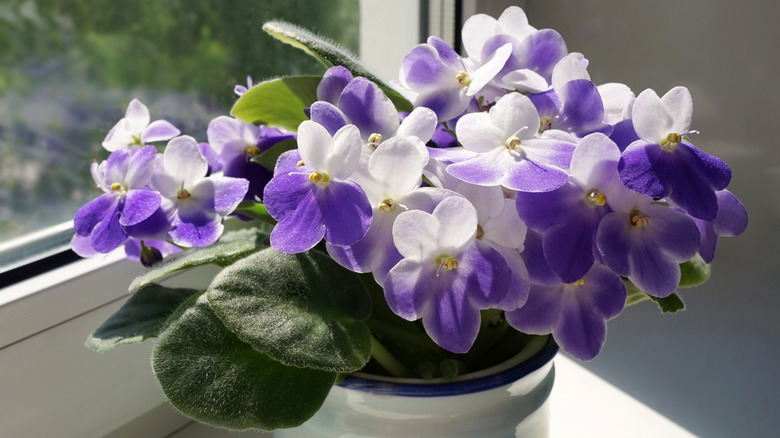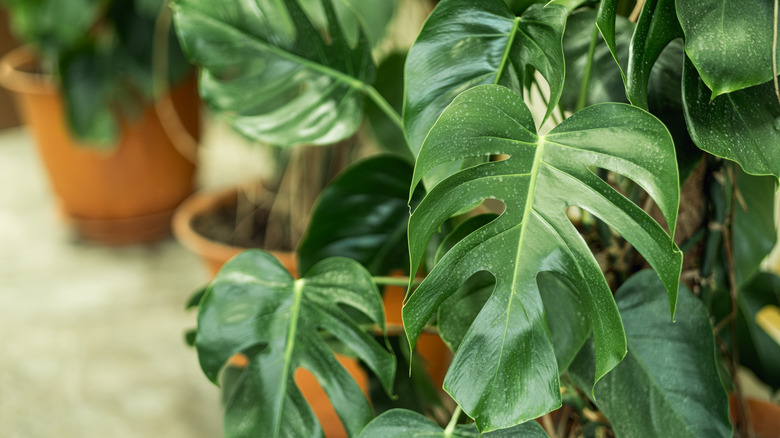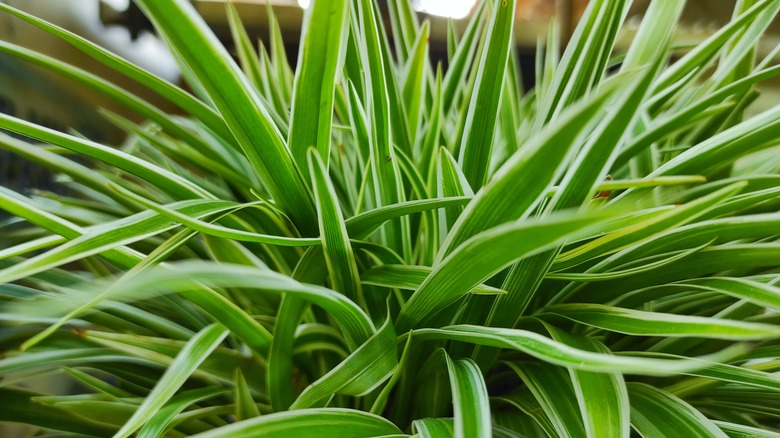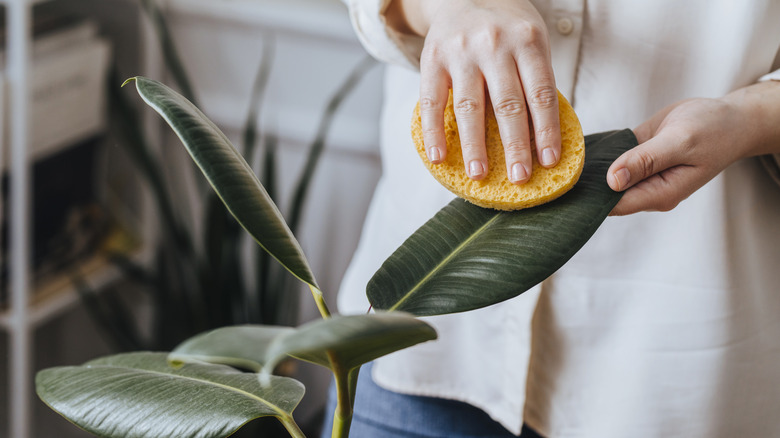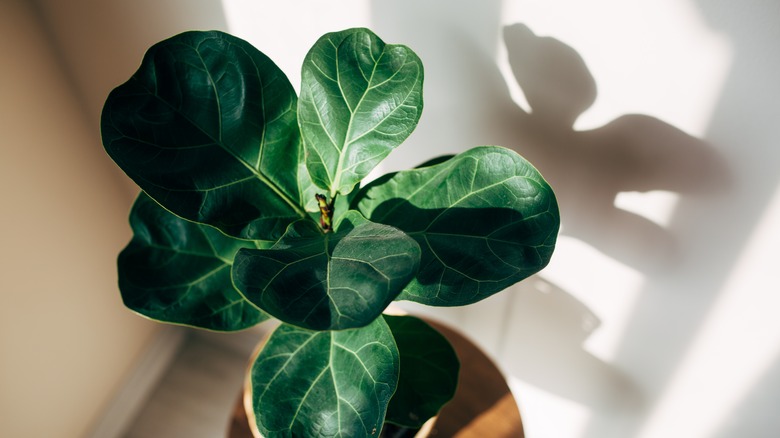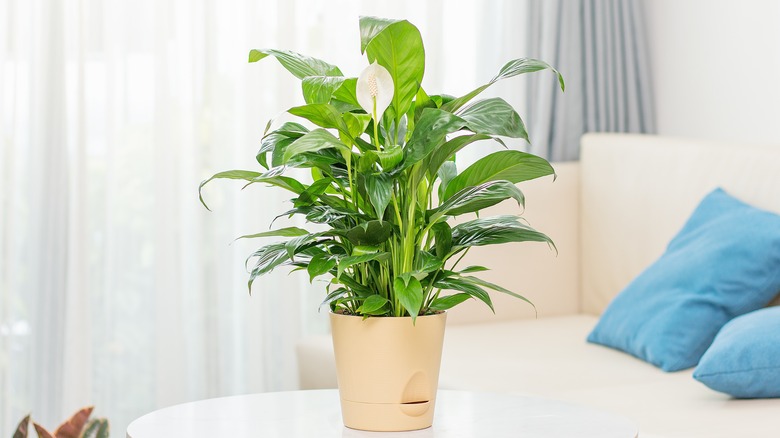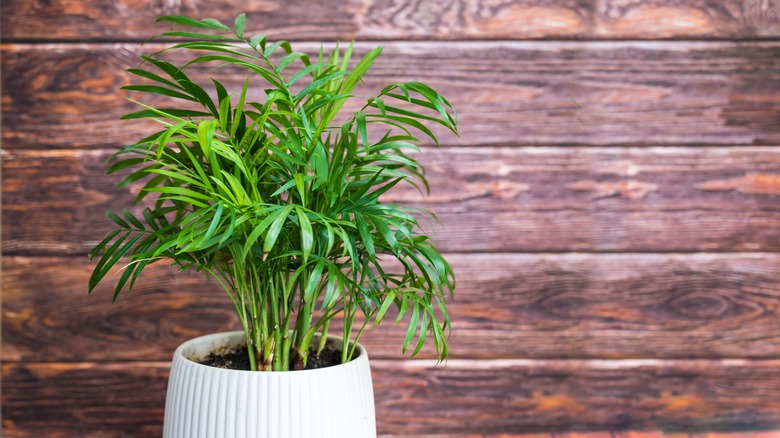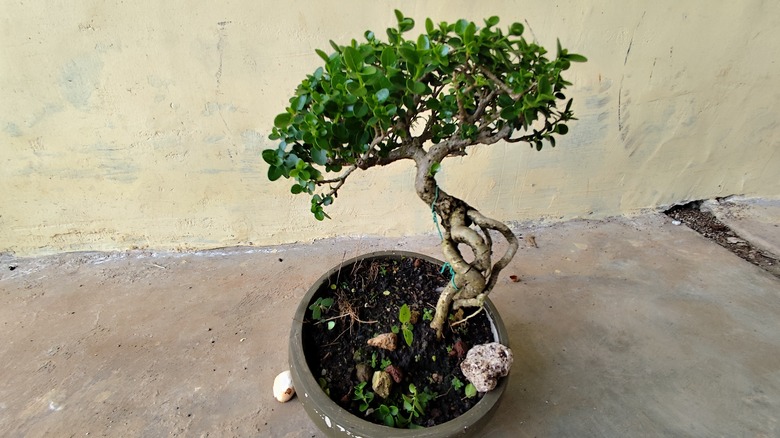Plants That Are Secret Dust Magnets In Your Home
We may receive a commission on purchases made from links.
Let's be real, nobody likes dusting (if you do, please come over). The never-ending battle against those microscopic particles is enough to drive anyone crazy. It's particularly frustrating after you've just completed a deep clean and then a sunbeam hits your living room — and there it is, your enemy that's seemingly regenerated and is ready to make your sinuses rebel.
Many people bring plants into their home because they think they'll help clean the air. Unfortunately, the truth is that these living pieces of decor are just adding a new spot for dust to live, can often be quite tricky to clean — and you have to clean them, both for the health of your home and for the health of the plant. While all houseplants will collect dust to some extent, there are certain species that really stand out as dust magnets, due to the size, shape, and texture of their leaves. Plants with large, broad leaves can, understandably, accumulate a ton of dust, but so can those with fine, feathery foliage. Plants with ribbed, waxy, or fuzzy leaves are another set of dust attractors, and cleaning them can be particularly tough. Below we've rounded up 12 of the worst offenders. Read on to learn why these plants end up with more than just sunshine on their leaves and how you can keep them dust-free and healthy.
What's the problem with plants attracting dust?
So what's the big deal if these plants get a little dusty? Well, it goes deeper than just aesthetics and allergies; turns out it's problematic for the plant, too. Plants use the surface area of their leaves to take in light and carbon dioxide, to create energy via photosynthesis. Leaves aren't just solid structures, they've got little holes over the surface called "stomata" that are responsible for pulling in the carbon dioxide needed for photosynthesis. If these stomata get clogged by dust the plant will have a harder time transpiring. Dust on the leaves also interferes with plants' ability to absorb sunlight, something that's already in short supply indoors.
Plus, let's not discount the problem layers of dust can have on human bodies, too. When dust accumulates on a leaf and then gets disturbed (like by watering or moving the plant) it will release allergens into the air, clogging your sinuses and making it harder for those with asthma to breathe. So do your plants and yourself a favor by making it a regular habit to dust leaves — you'll all end up happier and healthier from it.
Hairy philodendron has broad, intricate foliage and bristles that can hold onto dust
You might not know the hairy philodendron (Philodendron squamiferum) unless you're a rare plant collector, particularly since its offspring, Philodendron 'Florida Ghost' and 'Florida Beauty', are more popular. But the hairy philodendron deserves a spot on your windowsill too, as it's a cool, unusual variety with fine bristles covering its fuzzy red stems. Just be aware that these bristles can act like tiny dust catchers that trap airborne particles. Toss in the large leaves and occasional sticky secretion their extrafloral nectaries can release and you're looking at a one-two punch of dust-collecting problems.
Keeping your hairy philodendron looking its best requires a gentle touch due to the delicate bristles, which can dislodge easily. Microfiber cloths or gloves are ideal for wiping down the interestingly-shaped leaves, effectively lifting dust and transforming them back to their glossy green state. For the stems, you will need to gently experiment to find the best dust removal method. Do not run a cloth briskly over them, as this could damage the bristles. A soft paintbrush or even a can of compressed air could do the trick to loosen dust, just don't go crazy with the air sprays.
Old man cactus has a protective layer of fluff and spines that can capture dust
The old man cactus (Cephalocereus senilis) has a tall, columnar shape and is covered in thousands of white, hairy-looking spines. While it may look soft and fluffy, those spines are no joke; they're used to protect the plant from frost and sun damage and provide insulation from extreme temperatures. But those protective spines make this plant a formidable dust magnet, trapping particles within its intricate netting like an air filter. The spines will thin out as the plant ages, but since old man cactus plants can take over 200 years before they even reach their final height in the wild, it's safe to say you'll probably be waiting a while for that to happen.
Keeping this cactus clean isn't easy since getting poked with thousands of spines is no picnic. We recommend using a soft paintbrush or a few quick blasts of compressed air. If you decide to use compressed air, don't hit the plant front and center, as that could damage it. Instead, move the plant over to the side of the spray so that it just gets a little hit of air. Sticking this guy in the shower to remove dust isn't a good idea; cacti are susceptible to rot if they get too much moisture, and just imagine how difficult it would be to air the plant out with that coat of spines.
The panda plant is furry and slow-growing, making it a top dust collector
We're not sure which common name we love best: panda plant, teddy bear cactus, chocolate soldier, or velvet leaf kalanchoe, but whatever you call Kalanchoe tomentosa, you know it's an awesome, low-maintenance succulent to keep as a houseplant. The panda plant is covered in fine hairs that give its leaves and stems a fuzzy texture. It's slow-growing, and its lack of leaf shedding and full layer of fuzz make it a plant that's easily covered in dust and particularly hard to clean.
The main reason this succulent is so hard to dust is that its leaves can break off if you're not careful. Your best method for getting rid of dust trapped in the fuzz is an awesome houseplant care item you've probably already got lying around your home: a makeup or paint brush — use them to delicately go over the stem and leaves, making sure to dust the undersides, too. Compressed air can also be used to dislodge dust but you might lose a few leaves due to the force of the air. For a gentler, more controlled approach, you can try blowing dust off the leaves with a straw. Spraying or dousing your panda plant under the faucet is not recommended, as the leaves are prone to rot, so much so that it's often advised to water these plants from the bottom by placing them in a tray of water.
Fuzzy begonias can create static electricity on their leaves, making them literal dust magnets
Growing and taking care of begonias is surprisingly easy once you get the gist of it, making this diverse family popular houseplants. With over 2,100 different species in the genus, there are bound to be ones that have unique characteristics that make them fun to collect. The fuzzy begonia (Begonia peltata) is one of them, with leaves that have a velvet-like covering of hair that's only seen on a few begonia varieties. Unfortunately, that fuzzy texture created by the trichomes creates a kind of static electricity field that attracts dust like crazy. Plus, their delicate and intricate leaf shapes can make it hard to reach every nook and cranny to remove it.
To dust this plant you'll need to consider the fragile leaves that make it so appealing. Using a damp cloth as a dusting rag could damage the trichomes and you'll run the chance of getting water trapped under the hairs, creating a perfect environment for fungal diseases to thrive. Instead, stick to dry dusting methods. Makeup brushes, paint brushes, or very soft-bristled toothbrushes could work as long as you're gentle. If you have a larger specimen, here's a simpler method that will take less time than dusting each leaf: Gently shake the stems. This is particularly practical for furry-leaved begonias that can get super large, like Begoniato mentosa, but you can try it on a Begonia peltata as well. Simply grasp the stems loosely and agitate them. You might want to do this in an outdoor area where a breeze can carry the released dust away.
African violets have furry, dust-attracting, closely spaced leaves which shouldn't get wet
The charming African violet (Streptocarpus ionanthus) is one of the most popular houseplants thanks to its gorgeous, colorful blooms and soft, fuzzy leaves which are called "lobes." But that velvety texture that makes African violets so appealing also renders them hardcore dust magnets. Like other fuzzy plants, the hair-like trichomes covering the lobes are a perfect place for dust to land. Toss in the fact that most houseplant owners don't move their plants around very often, which could shake off some dust, and you've got a perfect storm for dust attraction.
One of the secrets to successfully growing African violets is getting rid of this accumulated dust — and keeping velvety-feeling leaves dust-free isn't easy, especially for such a small plant with dense foliage. Don't use a damp cloth on these or spray with water; that can damage the lobes and leave them prone to fungal issues, water spots, and overall bad times. Instead, go for a soft brush that has a little bit of structure, like an eyeshadow brush (not a sponge) a small, flat paintbrush, or a few artist's brushes. A quick hit of compressed air can also work wonders, especially for the hard-to-reach areas close to the stem. Don't forget to clean underneath the leaves as well.
The Swiss cheese plant has a lot of surface area for dust to land on and the fenestrations can make cleaning harder
The iconic Swiss cheese plant (Monstera deliciosa), with its large, dramatic leaves featuring distinctive holes and splits, is a popular choice for adding a touch of jungle vibes to any home. While its smooth, glossy leaves might seem less likely to accumulate dust than fuzzy varieties, their sheer size and all of those unique fenestrations (the holes in the leaves) actually make them surprisingly good at collecting dust and hard to clean. Plus, since these guys get huge and heavy, moving them around doesn't happen too often and allows them to get even more dust settling on all that leafy surface area.
Luckily, monstera leaves' glossy surfaces make them easy to dust; the fenestration nooks and crannies, less so. A damp cloth or paper towel is totally fine for cleaning these broad leaves. Gently wipe down each leaf, topside and underside, to remove dust and grime. You can also give the leaves a gentle rinse with lukewarm water in the shower or sink, just be careful that the soil doesn't get waterlogged or that water spots end up on the leaves. For hard-to-reach areas, like the splits and holes, a small sponge can be helpful, just don't try to force it through the holes.
Spider plants have slightly ridged leaves and a bushy structure, ideal for catching dust
The spider plant (Chlorophytum comosum) is a resilient little houseplant that can take a lot of abuse and neglect, often preferring you forget about it instead of being a helicopter parent. Spider plants have lots of thin, smooth leaves that can look like clumps of grass, and will often grow baby spider plants on their ends, ready to be picked and propagated. But the spider plant's long leaves have a very slight texture that's just enough to trap dust particles, especially if there's little airflow. The sheer number of leaves, the multiple baby spider plant offshoots that add more surface area, and their dense growth habits make spider plants excellent dust magnets.
Use a damp cloth or paper towel, fold it in half, and wipe down each leaf to clear off any dirt or dust. Or, if that seems like way too much of a challenge, grab a pair of microfiber gloves, like this pair of Microfiber Cleaning Gloves for Plants by JJUNW, and gently tussle the plant in its center, like the way you'd muss someone's hair, and work your way outward. Spider plants can also benefit from a trip to the sink or shower for a rinse, just be careful to keep their soil from getting waterlogged.
Rubber trees have a waxy coating on their broad and long-lived leaves that can grab onto dust particles
The rubber tree (Ficus elastica), is famous for its big, shiny, and almost leathery leaves that can reach up to one foot in length. The leaves also have a waxy coating that acts like a thin, protective layer, regulating water loss. You might think those smooth leaves wouldn't be big dust collectors, but all that surface area and ever-so-slightly sticky wax coating make these long-lived leaves (which can last for many years) prime real estate for dust particles.
To keep your rubber tree looking its best, dust it with a damp cloth or soft sponge, wiping both sides of each leaf. If there are any stubborn spots that seem like they're not giving up the dust, add a tiny drop of dishwashing soap to your cloth and go over it again. Make sure to rinse the leaf or wipe it with a soap-free damp towel again so that no residue gets left behind. If your tree is small enough, rinse it in the shower or take it outside and hit it with the hose. Just be sure to let the soil drain thoroughly; Ficus elasticas prefer their soil to dry out slightly between waterings.
Fiddle leaf figs are notorious dust collectors, thanks to their massive, slightly textured leaves
The fiddle leaf fig (Ficus lyrata) is another quintessential houseplant that's easy to care for and looks stunning in any room. Those stiff, broad leaves with their distinct veining might look smooth, but they have a slight texture. This, combined with all of that leaf surface area, makes this centerpiece plant a notorious dust magnet.
Like its cousin, Ficus elastica, fiddle leaf figs are pretty easy to clean with a damp cloth or paper towel. A sponge can also work well to get into all the undulations of the leaves. Just be careful not to handle them too roughly (those leaves are easy to accidentally pull off the stem) and place a hand underneath each leaf while cleaning to support it.
Peace lily plants have ultra-shiny, slightly ribbed leaves that easily collect and show dust
The peace lily (Spathiphyllum) is one of our favorite houseplants because it's so adaptable and tends to look gorgeous even when dealing with a little neglect. Those big lush leaves might look smooth to the naked eye but they've got a slight texture to them that lets dust settle faster than you'd think, turning their surface from glossy and green to gray and grimy in no time. Plus all of that dense, intermingled foliage creates a combination of both flat surface area and lots of little hard-to-reach pockets where dust can accumulate.
Getting your peace lily to flourish will require routine dusting. Due to all of that leaf density, you might want to pop this plant under the sink faucet or shower head and give it a rinse to remove any dust. If you want to clean the spadix, the yellow bumpy knob in the center of the white spathe, use a fine makeup or paint brush, but be extremely gentle. You can also spot-clean leaves with a damp cloth, just be sure not to leave any water spots behind.
Parlor palms have feathery fronds that can quickly trap dust
The parlor palm (Chamaedorea elegans) has been used as a houseplant for centuries and it's easy to see why. Not only are parlor palms one of the top indoor plants that can thrive in small spaces, but it's so elegant that this trait is even right there in its species name, elegans. Unfortunately, palms are notorious for collecting dust in homes, possibly due to their dense, feather-like fronds that create lots of corners and nooks for dust to accumulate. All of those leaflets increase the surface area of the plant, too, only adding to its dust-collecting potential.
Parlor palms can be dusted with a damp cloth, paper towel, or even those dusting wands, though they might not do as great a job as good old manual labor. For hard-to-reach areas, give the palm a hit of compressed air or just use a soft eyeshadow brush to dislodge the dust. Showers and rinses also work well for palms. Avoid leaf-shining products, as these substances can clog stomata.
Japanese pagoda has an intricate growth habit, and when grown as a bonsai will need regular rinsing
The Japanese pagoda (Styphnolobium japonicum) tree is a popular option for bonsai enthusiasts. However, its dense, tightly grouped leaves make it a haven for dust to accumulate, and incredibly hard to clean, especially because its leaflets are delicate and can fall off if handled too roughly. Interestingly, it's one of the few plants that have been studied to measure its dust-collecting abilities — a 2021 study in PLoS One tested the Japanese pagoda against five other ornamental trees and found its leaf structure made it the most effective tree for accumulating dust outdoors. Great.
So, how can you combat this tree's innate ability to collect dust? You can try a damp cloth and wipe down each leaflet, but you might run into issues as they're considered fairly delicate. If you're growing a bonsai tree from a Japanese pagoda, your best bet might be sticking it under a faucet and giving it a gentle rinse. If you've got an extendable faucet head with a spray function, even better, as this can help you get into all of those nooks where the foliage clumps together. As with all other plants that get a bath, make sure to let the soil drain thoroughly.
